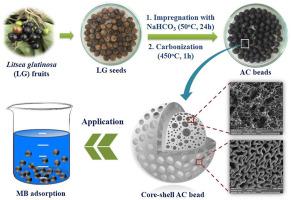Environmental Research ( IF 7.7 ) Pub Date : 2020-11-18 , DOI: 10.1016/j.envres.2020.110481 My Uyen Dao , Hoang Sinh Le , Hien Y Hoang , Vy Anh Tran , Van Dat Doan , Thi Thanh Nhi Le , Alexander Sirotkin , Van Thuan Le

|
In this study, natural core-shell structure activated carbon beads (ACBs) from Litsea glutinosa seeds were successfully produced, characterized, and applied for adsorption of methylene blue (MB). The ACBs were prepared using single-step carbonization-activation with NaHCO3 at the optimized activation temperature, time, and activating agent concentration of 450 oC, 60 min, and 5%, respectively. Batch experiments were performed to determine the optimum adsorption conditions, suitable kinetic and isotherm models, and thermodynamic parameters for the adsorption of MB onto ACBs. The results showed that the ACBs were displayed as highly porous natural core-shell spheres with a diameter of about 5 mm. The adsorption of MB dye on ACBs was a spontaneous endothermic process, followed the Langmuir isotherm and the pseudo-second-order kinetic models with the rate-controlling step of both external diffusion and intra-particle diffusion. At the optimum conditions (pH of 9, the contact time of 10 hours, the temperature of 40 oC, and an adsorbent dosage of 6 g/L), the maximum adsorption capacity reached 29.03 mg/g. The thermal method turned out to be more suitable for regenerating ACBs compared to the chemical method. The ACBs exhibited high reusability and stability, its adsorption efficiency could maintain more than 90% after five consecutive cycles of use. The electrostatic attraction, π–π interaction, hydrogen bonding, and pore-filling were identified as primary contributions to the adsorption mechanism. The overall results revealed that the ACBs could be used as a potential adsorbent for removing MB from water media.
中文翻译:

天然谷壳结构活性炭珠,衍生自Litsea glutinosa种子,用于去除亚甲基蓝:制备,表征和吸附性质
在这项研究中,成功地制备,表征和表征了来自Litsea glutinosa种子的天然核-壳结构活性炭珠(ACB),并将其用于吸附亚甲基蓝(MB)。通过在最佳活化温度,时间和活化剂浓度为450 oC的条件下,用NaHCO 3进行单步碳化活化来制备ACB 。C,分别为60分钟和5%。进行批处理实验以确定最佳吸附条件,合适的动力学和等温线模型以及将MB吸附到ACB上的热力学参数。结果表明,ACB表现为高度多孔的天然核-壳球,直径约为5 mm。MB染料在ACBs上的吸附是自发的吸热过程,遵循Langmuir等温线和拟二级动力学模型,并具有外部扩散和粒子内扩散的速率控制步骤。在最佳条件下(pH为9,接触时间为10小时,温度为40 oC,吸附剂量为6 g / L),最大吸附容量达到29.03 mg / g。事实证明,热化学方法比化学方法更适合再生ACB。ACBs具有很高的可重复使用性和稳定性,在连续使用五次后,其吸附效率可以保持90%以上。静电吸引,π-π相互作用,氢键和孔填充被认为是对吸附机理的主要贡献。总体结果表明,ACB可用作从水介质中去除MB的潜在吸附剂。











































 京公网安备 11010802027423号
京公网安备 11010802027423号